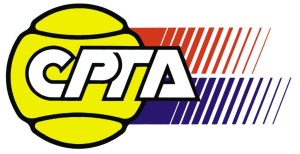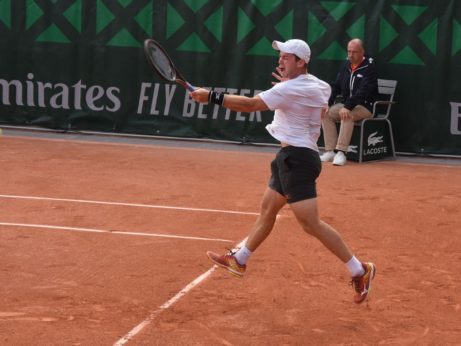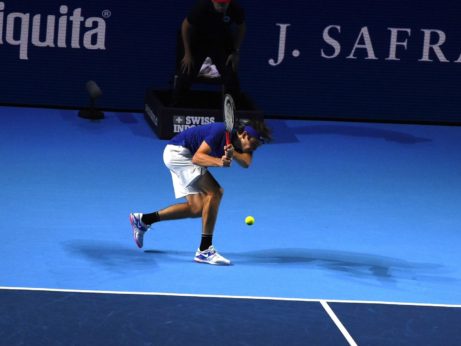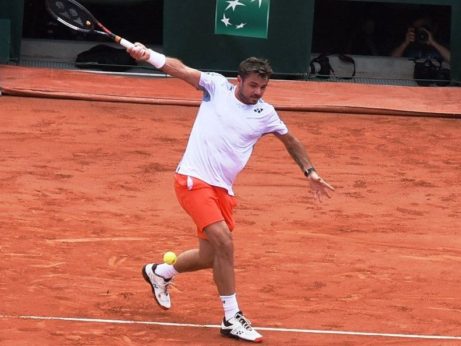Roger Federer – Efficient Service 3.0

Roger Federer (*81 / SUI), who eventually might be the best tennis player of all time, has a lot of great assets in his phenomenal game. The service is then one of the greatest among them. With his body size of 185 cm (6’1”), Roger can’t compete with the “Goliaths” like Karlovic, Isner or Raonic, but when compared to the other most dominant players of his era, he comes in most of the service relevant statistics on the top.
Roger’s service was always very good, but after improving some aspects in the Spring of 2009, it became even more dominant and got still a bit better margin. When comparing Roger to Andy Murray (his service is documented in another block on this website), Roger’s service has more pronounced pronation and he spends a higher percentage of the service energy on the dominant (=right) side of the body than Andy. Over his entire career on the tour (data until mid-January 2017), Federer has the 1st service percentage of 62% (Murray 58%, Djokovic 65%, Nadal 69%) of which he won 77% of the points (Murray 75%, Djokovic 73%, Nadal 72%). He also won 57% of points on his 2nd service (Murray 52%, Djokovic 55%, Nadal 57%). In total Federer won 69% of his overall service points (Murray 65%, Djokovic 67%, Nadal 67%). Federer’s ace probability per game is 60% (Murray 55%, Djokovic 44%, Nadal 27%, Raonic 113%, Isner 122%, Karlovic 142%) and his double fault probability per game is 15% (Murray 20%, Djokovic 18%, Nadal 13%). Also on the saving of the break-points is Federer slightly ahead with his 67% success quote (Murray 63%, Djokovic 66%, Nadal 66%). Pete Sampras has probably not his entire career documented in the statistics available (early years must be missing) but for comparison, his 1st service percentage is 59% of which he won 81% of the points, he also won 58% of the second services. Pete won 69% of his overall service points (same like Roger), had an ace probability of 83%, double fault probability of 28% and saved 68% of the breakpoints.
Photos below are from the 2014 US Open, where Roger lost in semifinals to the eventual winner Marin Cilic (CRO), and also from the 2007 US Open, which Roger won, as well as from 2009 US Open when he lost to Juan Martin Del Potro (ARG) in the finals. Besides other very important elements from the “Tennis 3.0 Code”, the essential aspect is the well-controlled targeted long-axis pronation after the impact in the first part of the follow-through, which I call the “follow-through 1”. This is where most of the stroke energy needs to be consumed. Through the entire service, Roger also well incorporates the 3-D helix action, which is then essential for the best possible reliability of the service and also other swing strokes.
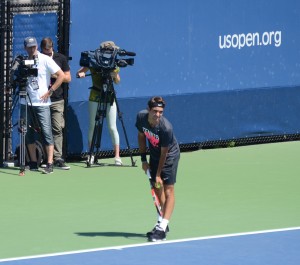
Roger Federer (*81 / SUI) – 1st service 3.0 in a practice – ad side – 1 of 4 – focused but also relaxed start – 2014 US Open – New York / USA
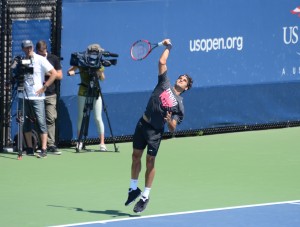
Roger Federer (*81 / SUI) – 1st service 3.0 in a practice – 2 of 4 – push-off / acceleration of the racket from the cocking position – racket edge perfectly lined-up, excellent eye control of the impact zone – 2014 US Open – New York / USA
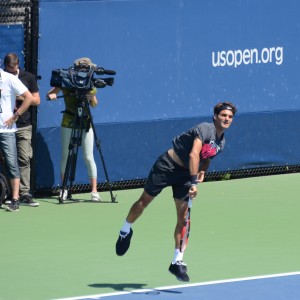
Roger Federer (*81 / SUI) – 1st service 3.0 in a practice – 3 of 4 – end of follow-through 1 of a helix form with targeted pronation – the right palm is facing for a long time to the outside – 2014 US Open – New York / USA
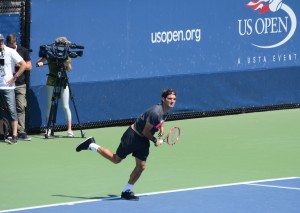
Roger Federer (*81 / SUI) – 1st service 3.0 in a practice – 4 of 4 – follow-through 2 aka relaxation, with a slight supination – 2014 US Open – New York / USA
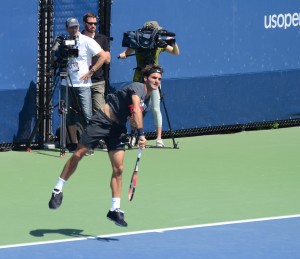
Roger Federer (*81 / SUI) – 1st service 3.0 in a practice – deuce side – 1 of 1 – end of the follow-through 1 with targeted long-axis pronation – the right palm is still facing to the outside – 2014 US Open – New York / USA
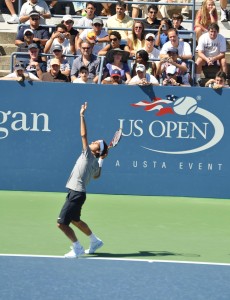
Roger Federer (*81 / SUI) – relaxed 1st service 3.0 in a practice – 1 of 4 – deuce side – toss / backswing – 2009 US Open – New York
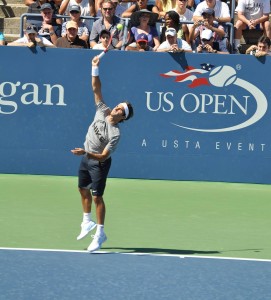
Roger Federer (*81 / SUI) – relaxed 1st service 3.0 in a practice – 2 of 4 – deuce side – approaching the impact with a perfect eye control of the ball – 2009 US Open – New York / USA
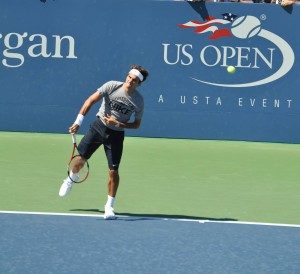
Roger Federer (*81 / SUI) – relaxed 1st service 3.0 in a practice – 3 of 4 – deuce side – end of the follow-through 1 with the palm still facing to the outside and a very controlled body posture – 2009 US Open – New York / USA

Roger Federer (*81 / SUI) – relaxed 1st service 3.0 in a practice – 4 of 4 – deuce side – follow through 2 = relaxation – 2009 US Open – New York / USA
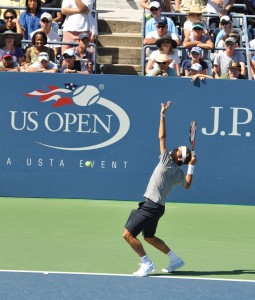
Roger Federer (*81 / SUI) – 1st service 3.0 in a practice – 1 of 4 – ad side – toss / backswing – 2009 US Open – New York / USA
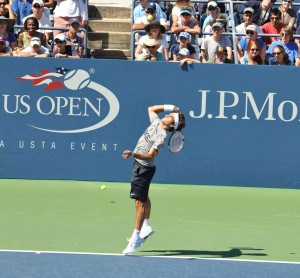
Roger Federer (*81 / SUI) – 1st service 3.0 in a practice – 2 of 4 – ad side – push-off / cocking – racket is perfectly lined up, excellent eye control – 2009 US Open – New York / USA
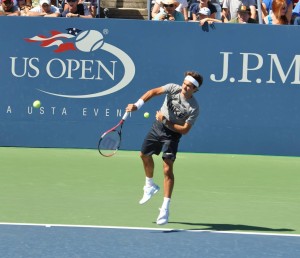
Roger Federer (*81 / SUI) – 1st service 3.0 in a practice – 3 of 4 – ad side – follow-through 1 of a helix form with targeted pronation and with a very controlled compact body posture – 2009 US Open – New York / USA
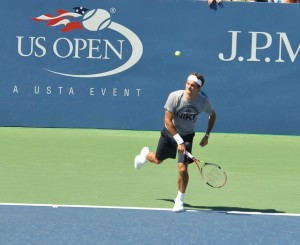
Roger Federer (*81 / SUI) – 1st service 3.0 in a practice – 4 of 4 – ad side – follow-through 2 aka relaxation – 2009 US Open – New York / USA
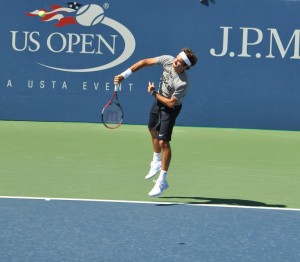
Roger Federer (*81 / SUI) – 2nd service 3.0 – topspin in a practice – 1 of 1 – ad side – follow through 1 with targeted pronation, here quite specific for the topspin service – 2009 US Open – New York / USA

Roger Federer (*81 / SUI) – 2nd service 3.0 – topspin in a practice – 1 of 1 – ad side – follow through 1 with the palm facing for a long time away from the body – 2009 US Open – New York / USA

Roger Federer (*81 / SUI) – 1st service 3.0 in a practice – 1 of 1 – deuce side – follow through 1 of a helix form with targeted pronation – the right palm is facing to the outside, controlled eye/head position – 2007 US Open – New York / USA
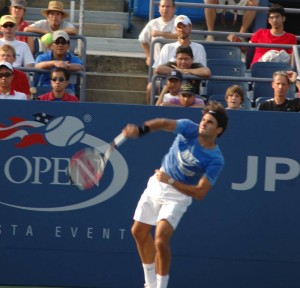
Roger Federer (*81 / SUI) – 1st service 3.0 in a practice – 1 of 1 – ad side – follow through 1 of a helix form with targeted pronation – the right palm points to the outside, head/eyes are stable, perfect control of the non-dominant (left) arm – 2007 US Open – New York / USA
This article covers certain aspects of Roger Federer’s service and service in general only! Further extensive photo galleries and more distinct details about his service and other strokes as well as about the strokes of other players are available upon a qualified request at drmgb11(at)gmail.com. Some significant details of this kind, necessary for the peak performance in modern tennis as well as for a sustainable tennis training/development in general, are being discussed also in the seminar “TENNIS 3.0 – Future of the Game”, which is available worldwide upon request – www.tennis30.com / www.tennis30.cz
Photos (August 2007, 2009 & 2014) & text (February 2017) copyright by Dr. Martin G. Baroch. Any further publication of either any of the photos and/or texts with the explicit written permission issued by the author/copyright owner only!! All instruction provided reflects just the personal opinion of the author and neither the author nor the CPTA accepts any responsibility for potential damages, direct or implied, of any kind!!
